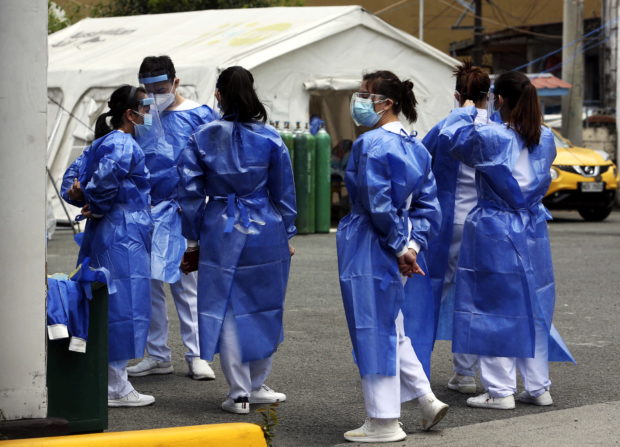Hospitals: Where have all the nurses gone?

Medical workers get ready for their shift at the Santa Ana Hospital in Manila on Tuesday, March 23, 20221. (File photo by MARIANNE BERMUDEZ / Philippine Daily Inquirer)
MANILA, Philippines — There has been a dearth of nurses even before the pandemic and the global health crisis only aggravated the situation, according to the president of a private hospital’s association.
“Prior to the pandemic, there has been a shortage but it worsened [such that] in every hospital, there is around [a] 30 percent lack of [nurses],” Jao Clumia, St. Luke’s Medical Center Employees Association president, said in a text message.
In their hospital system alone, Clumia said around 300 nurses were needed in the Quezon City and Taguig branches.
Health reform advocate Dr. Tony Leachon, in a post on June 6, also raised alarm over private hospital nurses “resigning in droves.”
“We need to prepare for our future. Exodus of HCWs (health-care workers) is real. I think migration is inevitable given the lack of better opportunities here,” said the former special adviser of the National Task Force Against COVID-19.
Article continues after this advertisementHe noted, however, that the “silver lining” was that there were many nursing graduates in the country. The Professional Regulation Commission last month announced that 6,616, or 68 percent, of the 9,729 examinees passed the May 2022 Nursing Board Exams.
Article continues after this advertisementJust recently, the Commission on Higher Education (CHEd) also lifted the curbs imposed on some higher education institutions to offer new nursing undergraduate and graduate programs.
CHEd Chair Prospero De Vera III said at a press conference last week that the decade-old moratorium implemented because of the “oversupply” of nursing graduates was reviewed at the height of the pandemic, which exposed the “perceived” lack of medical workers in the country.
“If you look at the total nurses in the Philippines and the current nurse-to-population ratio, you will notice that there is really a big gap in the supply side,” he said, citing data from the Department of Health (DOH) that served as their basis in reviewing the policy.
‘Cautionary note’
According to the DOH, the Philippines needed 201,265 nurses to meet the United Nations’ Sustainable Development Goals requirement of 27.5 nurses for a population of 10,000.
“The Philippines currently has 90,205 nurses but ideally it needs 300,470,” De Vera said.
A 2020 report commissioned by the International Council of Nurses (ICN) indicated that the “outflow” of nurses in the country reached 15,000 to 20,000 annually in recent years.
However, the yearly number of nurses who have passed that licensure exam “dropped significantly,” from an average of 45,000 in 2012 to less than 10,000 in 2018 and to more than 12,000 in 2019.
In the same report, the Philippines was listed along with India as one of the two countries that were major sources of international nurses working in Organization for Economic Cooperation and Development countries.
It noted the country’s “train for export” model of nurse education, which ultimately led to the oversupply of nurses and CHEd’s imposition of the moratorium in 2011.
“The Philippines provides a cautionary note,” ICN said, emphasizing that a nurse education system developed for the “export market” and driven by fast proliferation in private nursing schools could result in “over-expansion of training output, risks lowering standards, and may result in nurse unemployment.”
In a journal article published in the Journal of Global Health, Rowalt Alibudbud of De La Salle University cited chronic understaffing, low wages, unsafe working conditions and overseas deployment bans as among the reasons why Filipino nurses were “exhausted and dismayed” with the current health-care system of the country.
“If these are not addressed, health-care workers, as exemplified by the resignation of Filipino nurses, may leave their profession and institutions to seek opportunities where their work is valued, and their rights are upheld,” Alibudbud said in his article.
‘Tipping point’
In December last year, the ICN warned that the numbers of nurses around the world were falling further just as the Omicron coronavirus spread, and there was also an imbalance as Western countries step up recruitment of health-care workers from less developed and poorer countries.
“I think that we are at a tipping point … if those numbers continue the trend that we are seeing, it could be an exodus of people,” said Howard Catton, CEO of the Geneva-based group that represents 27 million nurses in 130 national associations.
“I almost think that governments need to be thinking about the life support package of measures they need to be putting together to invest in their nurses and their health-care workers next year,” he said.
RELATED STORIES
Nurses’ exodus: Choice obvious between better future abroad, shabby treatment at home
Global shortage of nurses set to grow as pandemic enters third year – group